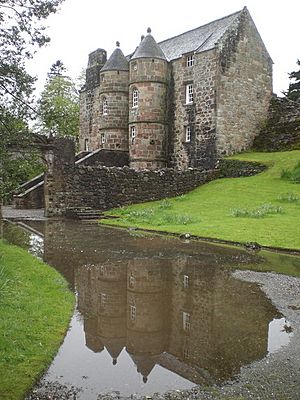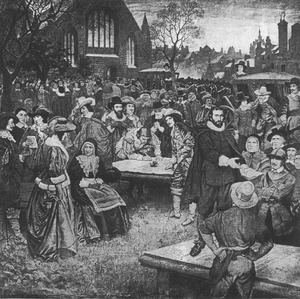William Mure (writer) facts for kids
Quick facts for kids
Sir William Mure of Rowallan
|
|
|---|---|
| Member of the Parliament of Scotland for Ayrshire |
|
| In office 22 June 1643 – 3 June 1644 |
|
| Preceded by | Henry Montgomerie |
| Succeeded by | Sir John Crawford of Kilbirnie |
| Personal details | |
| Born | 1594 |
| Died | 1657 |
| Nationality | Scottish |
| Spouses |
Anna Dundas
(m. 1615; Jane Hamilton, Lady Duntreath |
| Children | 15 |
| Parents | Sir William Mure Elizabeth Montgomerie |
| Relatives | Alexander Montgomerie (uncle) |
| Residences | Dalmusternock Rowallan Castle |
Sir William Mure of Rowallan (1594–1657) was an important Scottish writer and politician. He is known for his poetry and his role in Scottish politics during a time of great change.
Contents
Sir William Mure's Early Life

William Mure was born in 1594. His father was also named Sir William Mure of Rowallan. His mother was Elizabeth Montgomerie. The family lived at the Rowallan estate, which is near Kilmarnock in Ayrshire, Scotland.
The Mure family was very old and respected in Scotland. An ancestor, Elizabeth Mure, was the first wife of King Robert II of Scotland. King Robert II was a Scottish king who lived from 1316 to 1390. Elizabeth Mure was also the mother of King Robert III.
Sir William Mure's Career and Writings
Sir William Mure started writing when he was young. His first works were written between 1611 and 1617. These included love poems and sonnets. A sonnet is a poem with 14 lines. He also wrote a poem called Dido and Aeneas, which was based on a famous old story.
In 1617, he wrote a poem to welcome King James VI and I to Hamilton. This poem was published in a large book called The Muses Welcome the next year.
Political Role and Public Service
In 1639, William Mure's father passed away. William then inherited his father's title and became the Laird of Rowallan Castle. He lived at the castle from then on.
He became a member of the Scottish parliament in 1643. He also took part in a military campaign in England in 1644. During this time, he was injured at the Battle of Marston Moor. However, he was back leading a group of soldiers in Newcastle just one month later.
Later Writings and Religious Beliefs
Sir William Mure's later writings were very different. They showed his strong belief in Calvinism. This was a type of Protestant Christianity. He also supported the Presbyterian way of running the church.
In 1628, he published a spiritual hymn. It was a translation of a Latin work by a theologian named Robert Boyd of Trochrig. Mure then wrote his own long poem about the Last Judgment. He also added three sonnets called ‘Fancies Farewell’. In these poems, he expressed regret for how he had spent his younger years.
In 1629, Mure published a very long poem called The True Crucifixe for True Catholikes. This poem strongly criticized Roman Catholicism. Other famous writers, like Drummond of Hawthornden, wrote short poems to introduce Mure's work.

Mure was also influenced by James Melville's writings. This can be seen in Mure's sonnet collection called The Joy of Teares, published in 1635. This collection strongly opposed the bishops and the king's control over the church. At this time, there was a lot of tension between King Charles I and the Presbyterians.
Because of these tensions, Mure did not put his name on The Joy of Teares. He wrote on the title page that the book was published "with the gratious licence and privilege of GOD Almighty." He also wrote that he did not use his name because "blameless Truth dar scarce appear."
After the National Covenant was signed in 1638, Mure wrote in support of it. The Covenant was an agreement to protect the Presbyterian church in Scotland. In 1640, he published a poem that spoke out against those who opposed the Covenant. His last published work was The Cry of Blood and of a Broken Covenant in 1650.
Sir William Mure also worked on a poem that rewrote the Psalms. He also started writing a history of his family, called Historie and Descent of the House of Rowallane. These works were not fully finished.
Mure loved music. His lute-book and a book of songs are kept at Edinburgh University Library. You can even listen to the music from his lute-book online.
Sir William Mure's Family Life
Sir William Mure was married two times. His first marriage was in 1615 to Anna Dundas. Anna was the daughter of John Dundas, Laird of Newliston. William and Anna had five sons and six daughters. Sadly, only one daughter lived to adulthood before Anna passed away in 1644.
Their children included:
- Sir William Mure of Rowallan (1616–1686), who married Elizabeth Hamilton.
- Captain Alexander Mure (1618–1648), who was a soldier and died in the Irish Confederate War.
- Sir Patrick Mure (1622–1700), who was given the special title of baronet in 1662.
- Joan Mure, who married Uchter Knox, Laird of Ranfurly.
After Anna's death, William married Jane Hamilton. Jane was Lady Duntreath. They had two sons, James and Hugh, and two daughters, Jane and Marion.
Descendants and Family Legacy
Sir William Mure's eldest son, William Mure (1616–1686), took over the Rowallan estate. He was a strong supporter of the Reformed church beliefs. He was even put in prison twice for his beliefs. Once in Stirling Castle in 1665, and again in Tolbooth in Edinburgh in 1683. His son, also named William Mure, was imprisoned with him.
Sir William Mure's grandson, William Mure of Rowallan (died 1700), was a student at the University of Glasgow. He was also a member of the Scottish Parliament. He had three daughters, but only one, Jean Mure (died 1724), lived to adulthood.
Jean Mure married twice. Her second marriage was to David Boyle, 1st Earl of Glasgow. After Jean's death, her daughter, Lady Jean Boyle Mure of Rowallan, inherited the estate. Lady Jean married Sir James Campbell in 1720.
Their son, James Mure Campbell (1726–1786), inherited the Rowallan estate. He later became the 5th Earl of Loudoun. His daughter, Flora Mure-Campbell (1780–1840), became the 6th Countess of Loudoun. She married Francis Rawdon-Hastings, 1st Marquess of Hastings in 1804.

